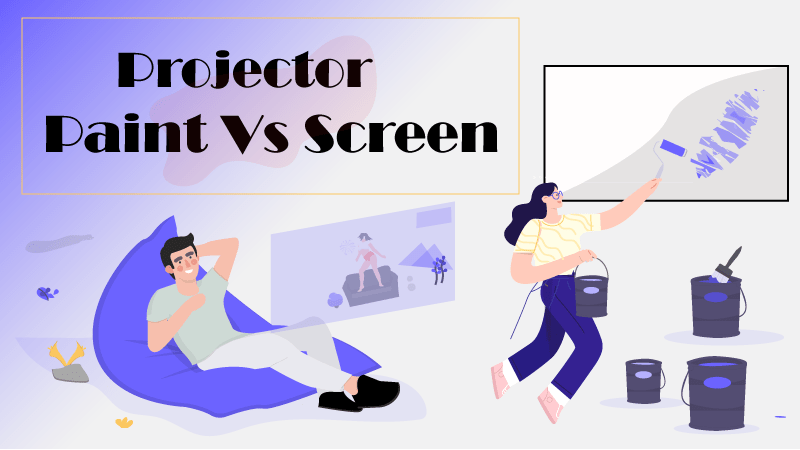Applying the best projector paint on a wall is an option to replace your actual projector screen? Well, lots of things to consider when up for the one. I’ll tell you the real difference: Projector paint projection on Wall Vs Screen.

You’ve got your couch, movie schedule, and projector ready, and now you need to take a vital decision. How pleasant the viewing experience will be for you, the family, or the team who’s going to do all that watching with you rests on your shoulders as you make this choice of what display to use, a projector paint or (vs) screen.
Deciding to start your evaluation by knowing the difference between the two is a smart move. You deserve to get nothing but the best value for your money, no matter how many bucks it is.
To exclusively answer which is better between a projector paint and a projector screen, I’d say the answer depends on your preferences and what you consider the ideal experience.
However, I’d love to look at the perks and downsides of both options to guide you through picking what works best for you.
Is Projector Paint as Good as a Screen? Is it a good alternative to an actual projector screen?
There is a noticeable difference between using a painted wall and a screen for video projection. The painting and finishing you give to the wall surface also determine how huge the difference will be.
Let’s look at the advantages and disadvantages that would come with using either of the two.
What is projector paint? Turns any surface or wall into a projector screen?
A projector paint is a smart coating developed with special self-leveling compounds that allows you to transform any surface(smooth surface) into a projection screen of any size or shape.
Why projector paint?
Okay, maybe the definition seems complex, but if this paint is supposed to work magic on your wall, then a good effort should be put into the formula. So now, why should you use this complexly defined projector paint instead of simply buying a Screen and hanging it on your wall? Let’s get to the projector paint vs screen conversation.
How to apply your first projector paint on your favorite surface or wall?
1. Setup: Should I be a pro to get started with the projector paint?
Even though applying the projector paint requires more time, it can be applied by anyone, doesn’t require a Udemy certificate or special training. However, it is time-consuming because if the surface isn’t smooth enough and flat, the projected image will suffer distortions like shadows and blur.
To avoid this, you should grind and sand down the wall with sandpaper or a power sander. To do the smoothening, turn off the lights, use a flashlight to see the wall closely, then run your hand around the surface to feel it. This carefulness helps you to avoid missing a spot. Once the wall is smoothened, apply two layers of your smart paint and wait for it to dry off.
Note: Remember the first layer needs to dry off before adding the second (you’ll need to exercise some patience here, K!)
2. Size: What is the limit? What size can I expect while applying the projector paint?
With a painted screen, you are the only limit. You decide where you want to stop the paint. You can go ahead and paint the entire wall or ceiling or choose a marked-out section to define the edges and help you focus.
3. Space: Do different surfaces matter? What is the ideal space?
If you do not have a dedicated theater, using a painted wall is your safest bet. You can always move furniture away from around the wall and enjoy your viewing.
4. Price: Are projector paints expensive than actual projector screens?
The price of a projector’s paint depends on the quality and the purpose you want to achieve. A basic projector paint for home viewing will cost less, starting from $75, but a gallon made for high-end commercial use like conference rooms or convention centers can cost as high as $1500 and for a start. It’s important not to put so much focus on the price but the price value.
5. For Leisure: Quality time with your loved ones
This may not be the first, or even the fifth thing that comes to mind when trying to choose a projector paint over a screen but seeing the painting and setup process as an opportunity to bond with the family, kids, friends, or team is also a fun way to look at it.
You can start by rubbing paint all over each other(careful though, that paint might be expensive) and then end up with a sleek family-made projector screen on your wall.
The Advantages: Why Projector Screen? Why is it an ideal option for most people?
A projector screen is the ideal display surface for images from your projector, and it was made for this! From conception of the idea to production and delivery to your doorstep as a consumer, screens are specially made to deliver the best possible pictures. It is an installation consisting of a surface and a support structure.
We’ve seen some reasons why you should use projector paint; now we have to give the screens a chance to win your heart too. So let’s discuss reasons why you should consider using a projector screen.
1. Light and Color: The biggest advantage
Projector screens have a special optical coating that ensures a better reflection of images. A projector has defined lines and appearance and will help direct and focus the light from your projector back into your eyes. It also helps to manage consistency in the flow of light and reflection throughout the viewing time.
2. Frame: A dedicated frame vs. Your DIY frame
Even though you can create a DIY frame while using a projector paint on your wall, not everyone knows to do this, and most importantly, it can’t be as defined as the dedicated frame that comes with your screen.
3. Mobile: Carry it along with you wherever you want, around the globe
You can move your projector screen around. So whether you need to lend it to your local town hall or for a presentation at work, you know your projector screen can take the trip with you without taking down your ‘wall’ (no shade intended!).
4. Easy and Quick to Set up: It doesn’t take much time
Setting up your projector screen requires the help of a professional, but it doesn’t take time. All you need to do is get a competent technician, and before you know it, you’ll be grabbing popcorn or your gamepad.
The disadvantages: Some Downsides To Using a Projector Screen
Although a screen is supposed to deliver the ideal viewing experience with a projector, if you place it side by side with its alternative(projector paint), it has some disadvantages.
1. Not so flexible: Dimensions are everything, don’t miss it at any cost!
A can of projector paint usually covers a complete wall, and if you eventually need to increase the size of your screen, it wouldn’t be a biggie. But this isn’t the case with projector screens. You have to get the right dimensions that’ll fit your projector’s display perfectly.
2. Screens are Pricey: Expensive doesn’t always mean greater quality.
Screens have more value, and so they generally cost more. However, it still depends on the quality and type of screen you opt for.
3. Takes up more space: Mounting sucks!
Since projector screens have a more defined width and length, they are bound to take up more actual space. However, there are options to mount it on the wall or ceiling permanently.
What is the perfect color to paint a wall as a projector screen?
Maybe you’re already convinced that a projector paint is the best choice for you, and now it seems difficult to find the best color to use for your screen since there are so many options; I’ll provide you with some insights to help you make the pick.
1. White: The most popular one known for a better reflection
White is the most popular choice for wall screen projection. This is because a white object naturally reflects any other color.
2. Gray: It ensures better contrast and black levels
If your room or office walls are already painted in gray, you don’t want to change them? You’re in luck. Gray paint is best for better black levels and contrast, and you don’t have to change the entire look of your space, especially if it has ambient light.
3. Silver: Somewhere between Gray and White
Silver paint is a shade close to white projector paint, so it is also highly reflective. Therefore, you can use a silver projector paint and still enjoy your view even if there isn’t enough supply of light from the lamps.
Conclusion: Let’s Wrap the topic “Projector Paint Vs Projector Screen” up!
To wrap it up, whatever side you’re tilting to, whether projector paint or screen, or white or grey paint, or portable or ceiling-mounted screen, you deserve to have a good and stress-free time while using your projector. So make sure to invest as much as you can into your relaxation and efficient viewing, and this should be an ample guide to ensure you make the best choice.

